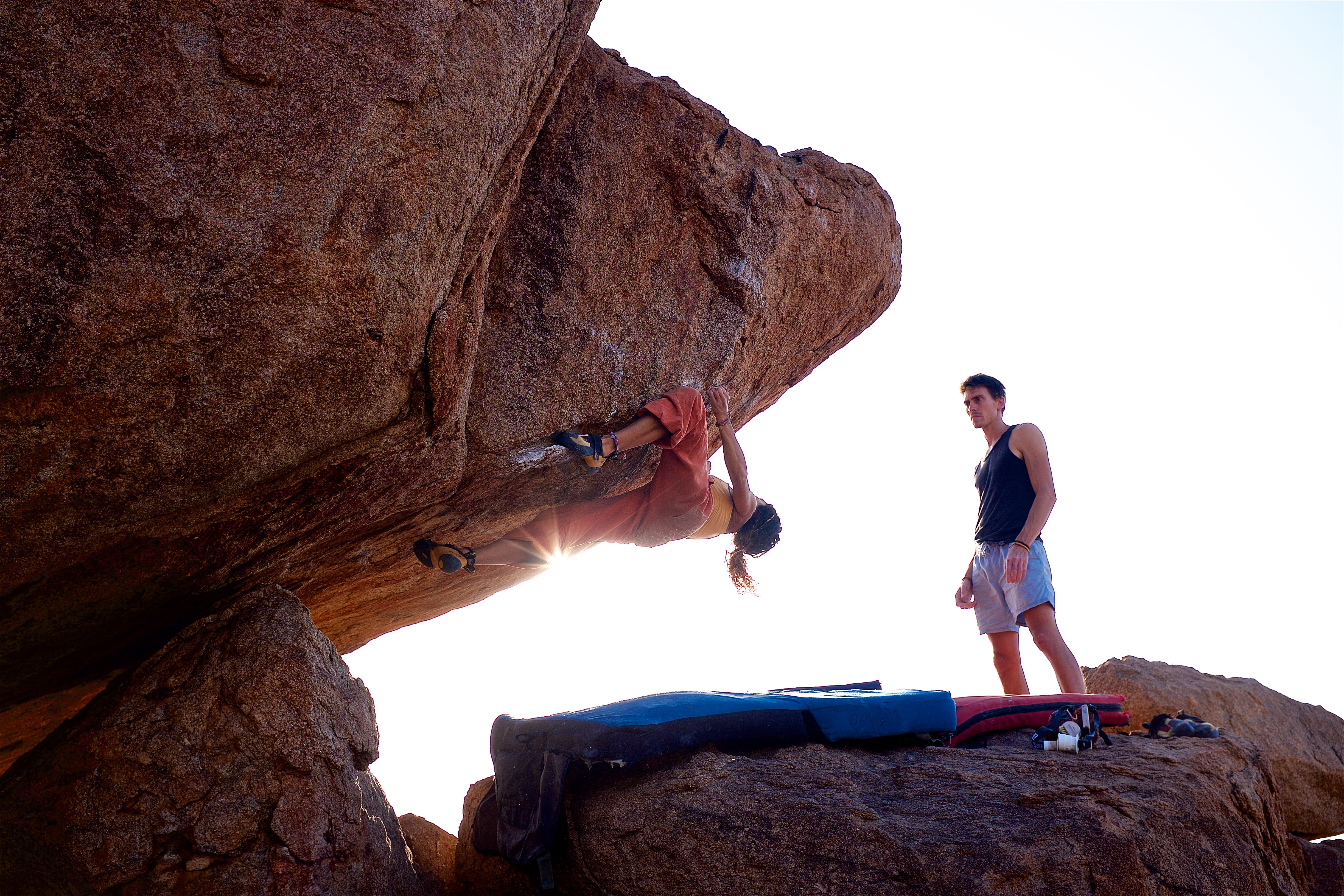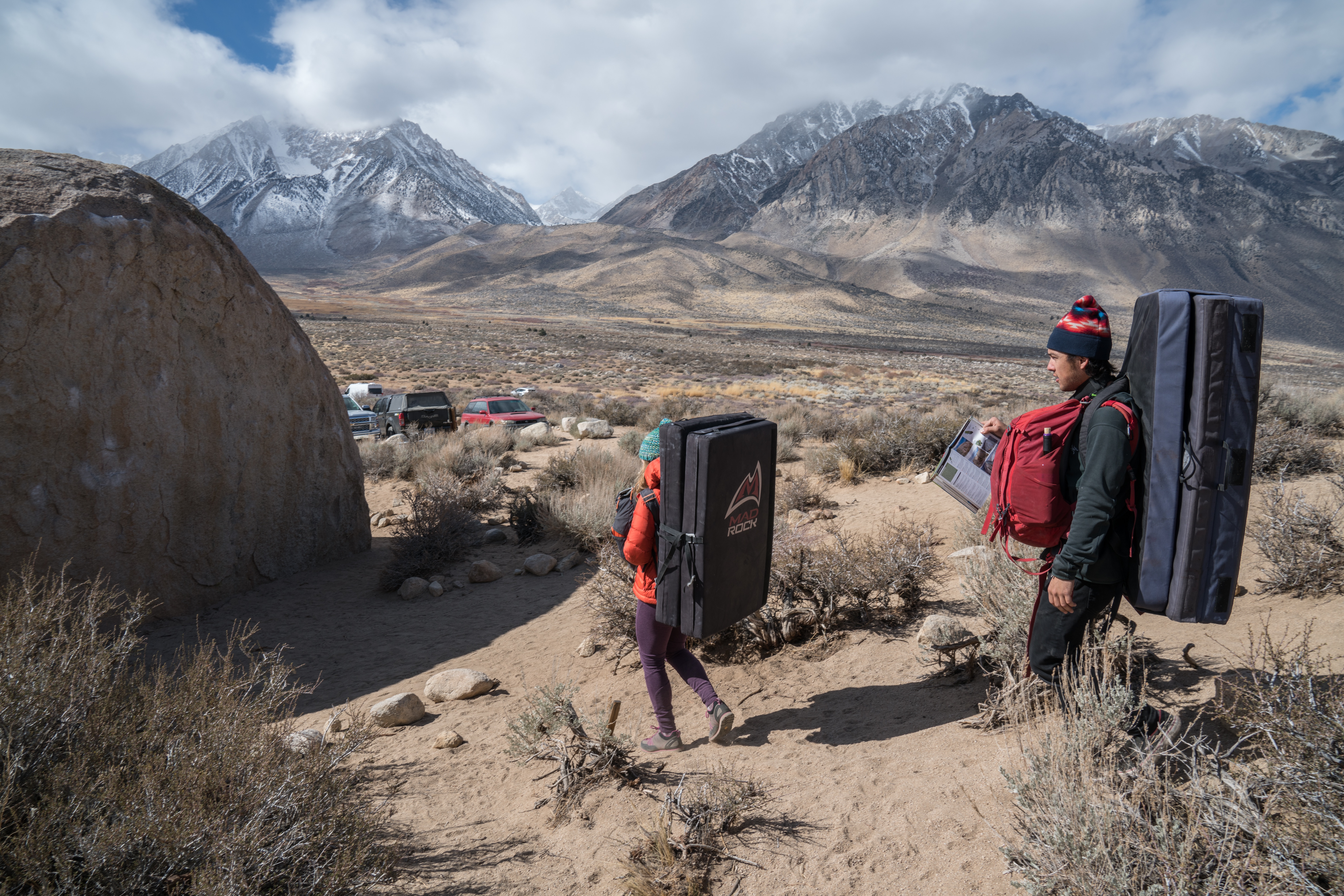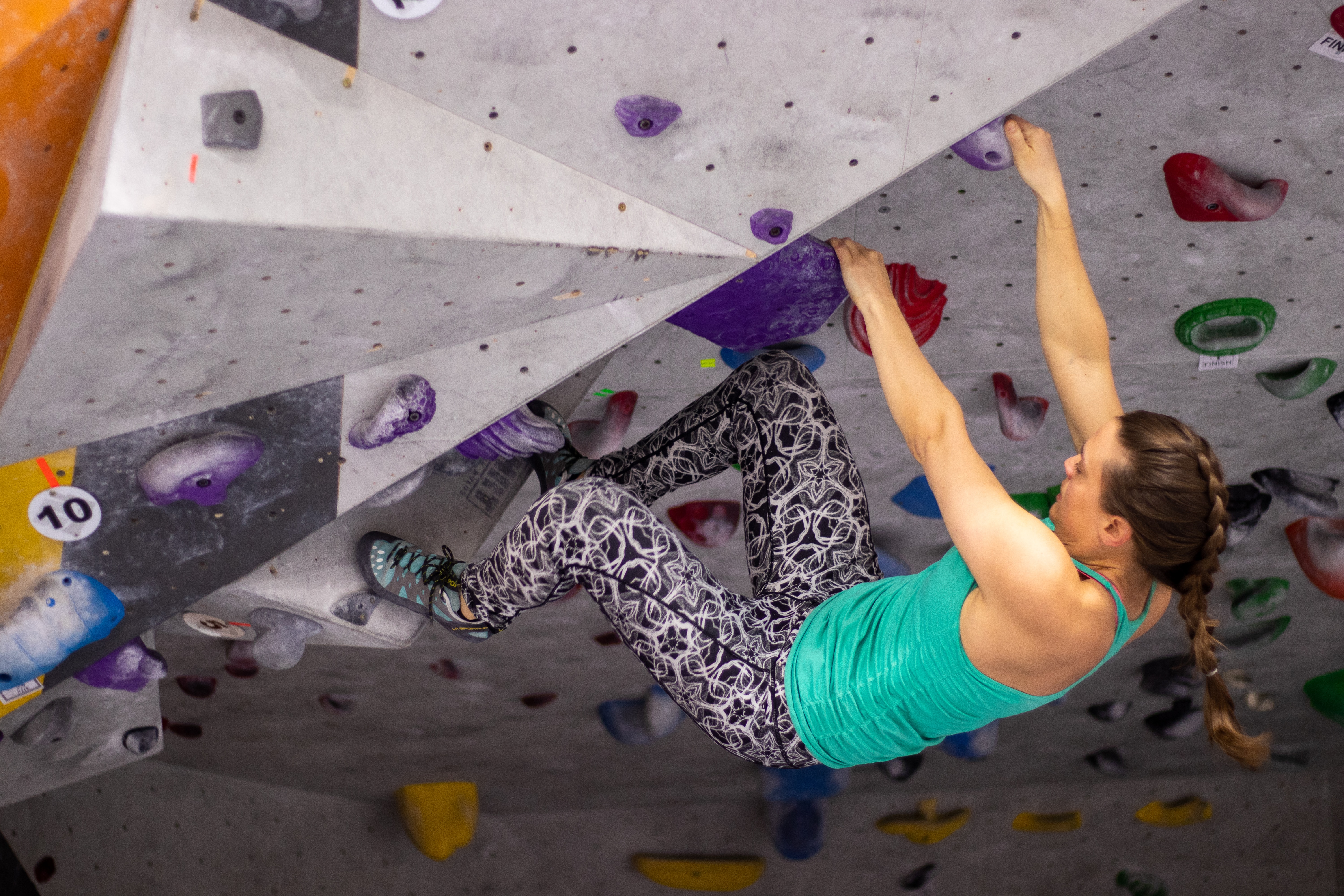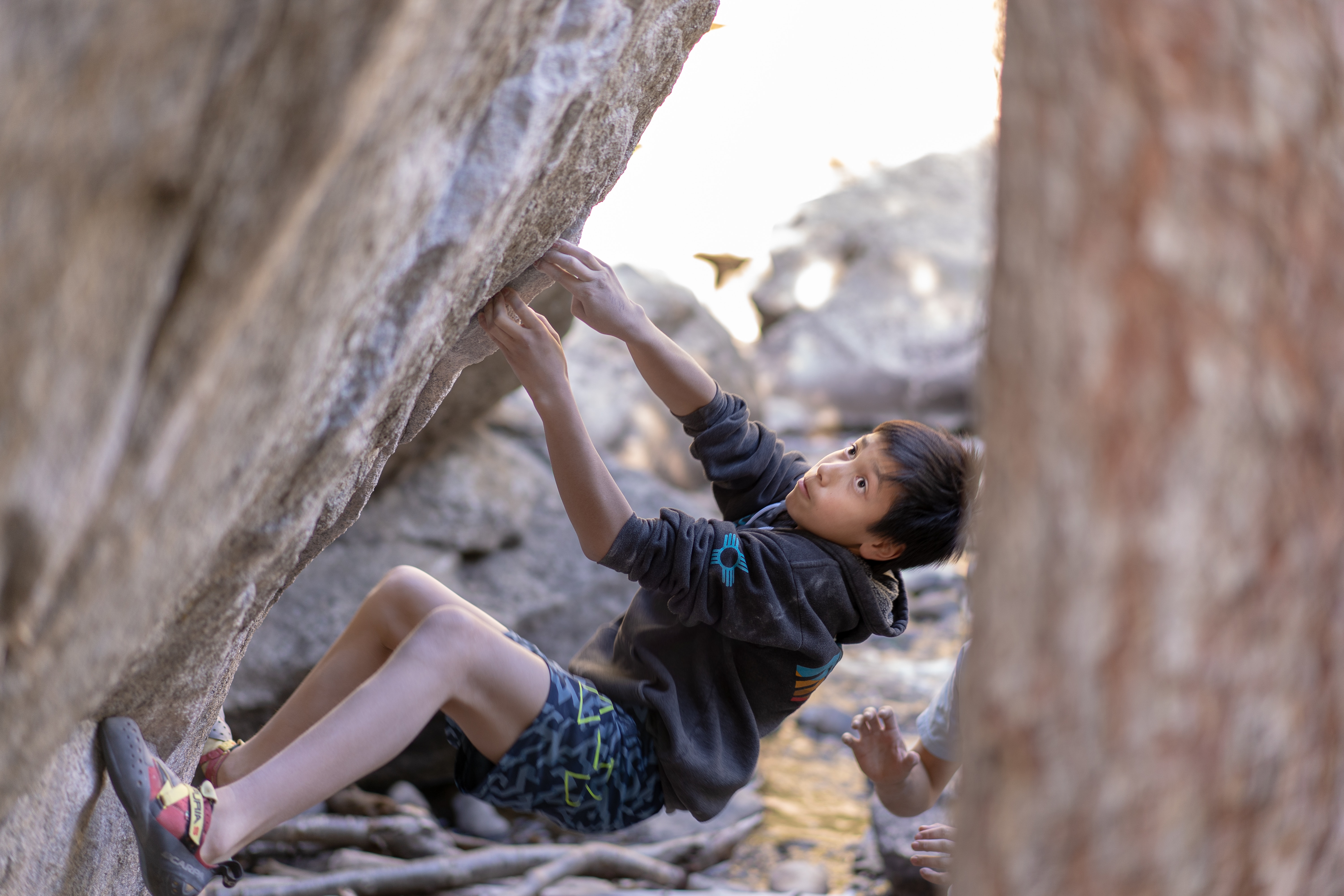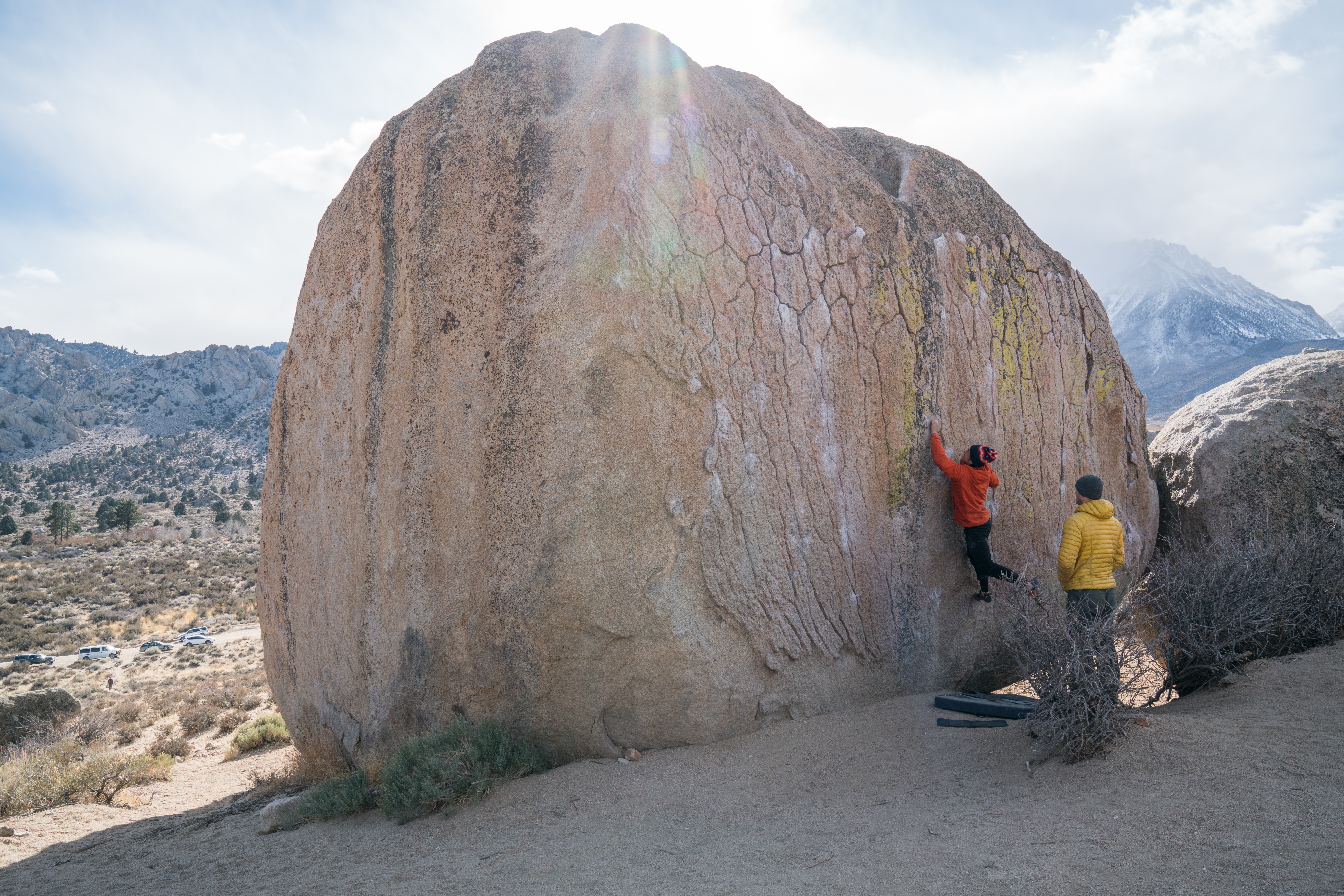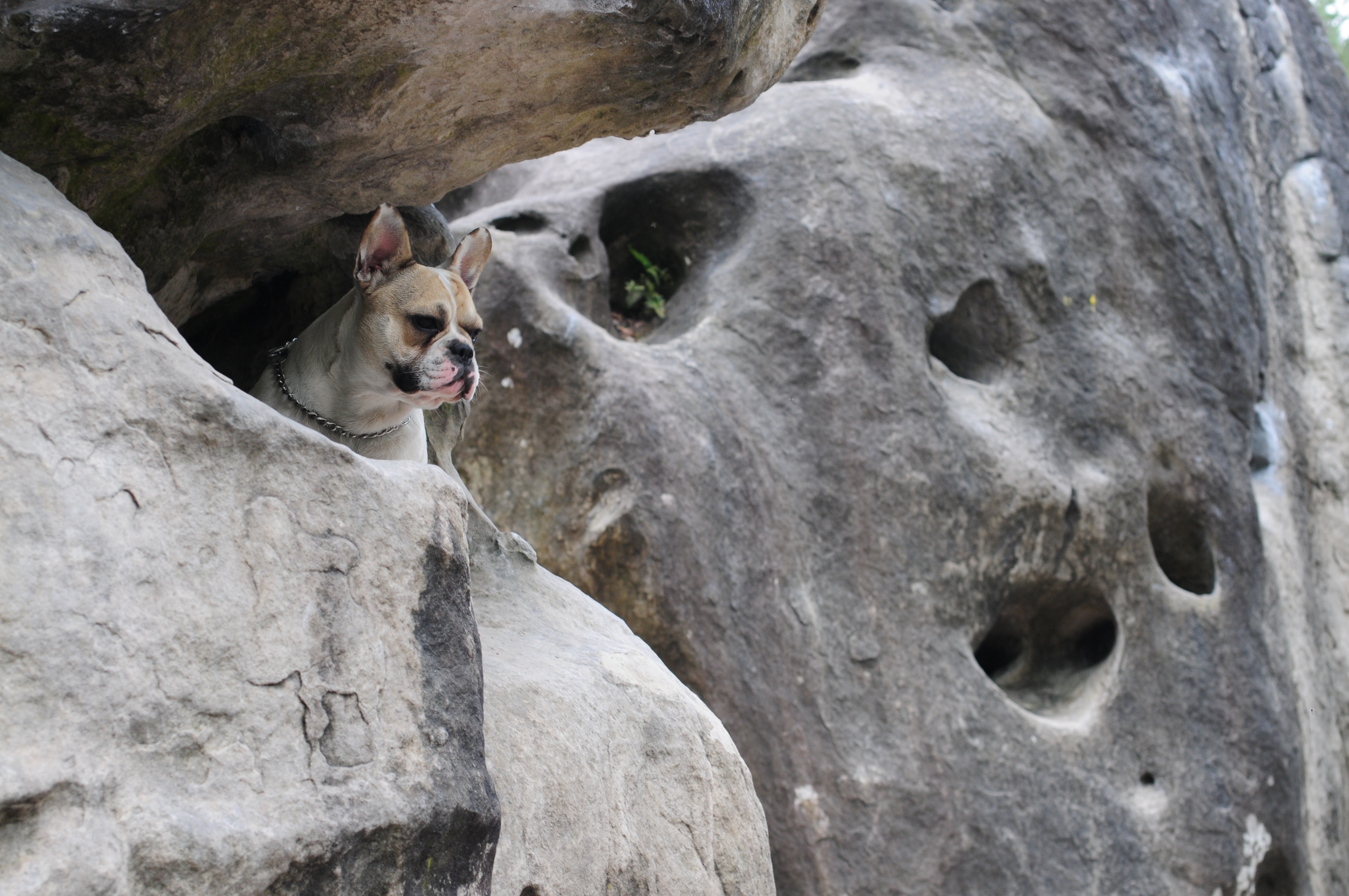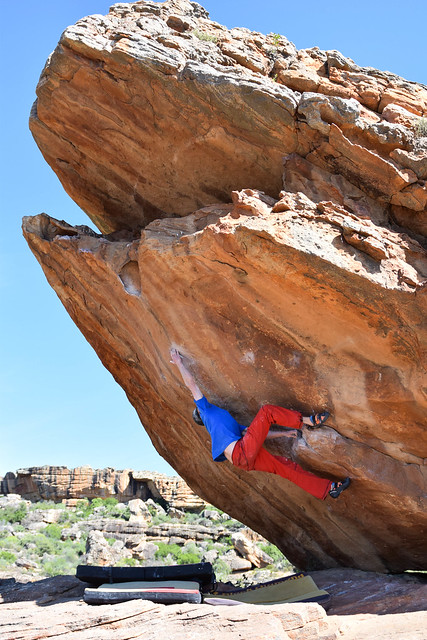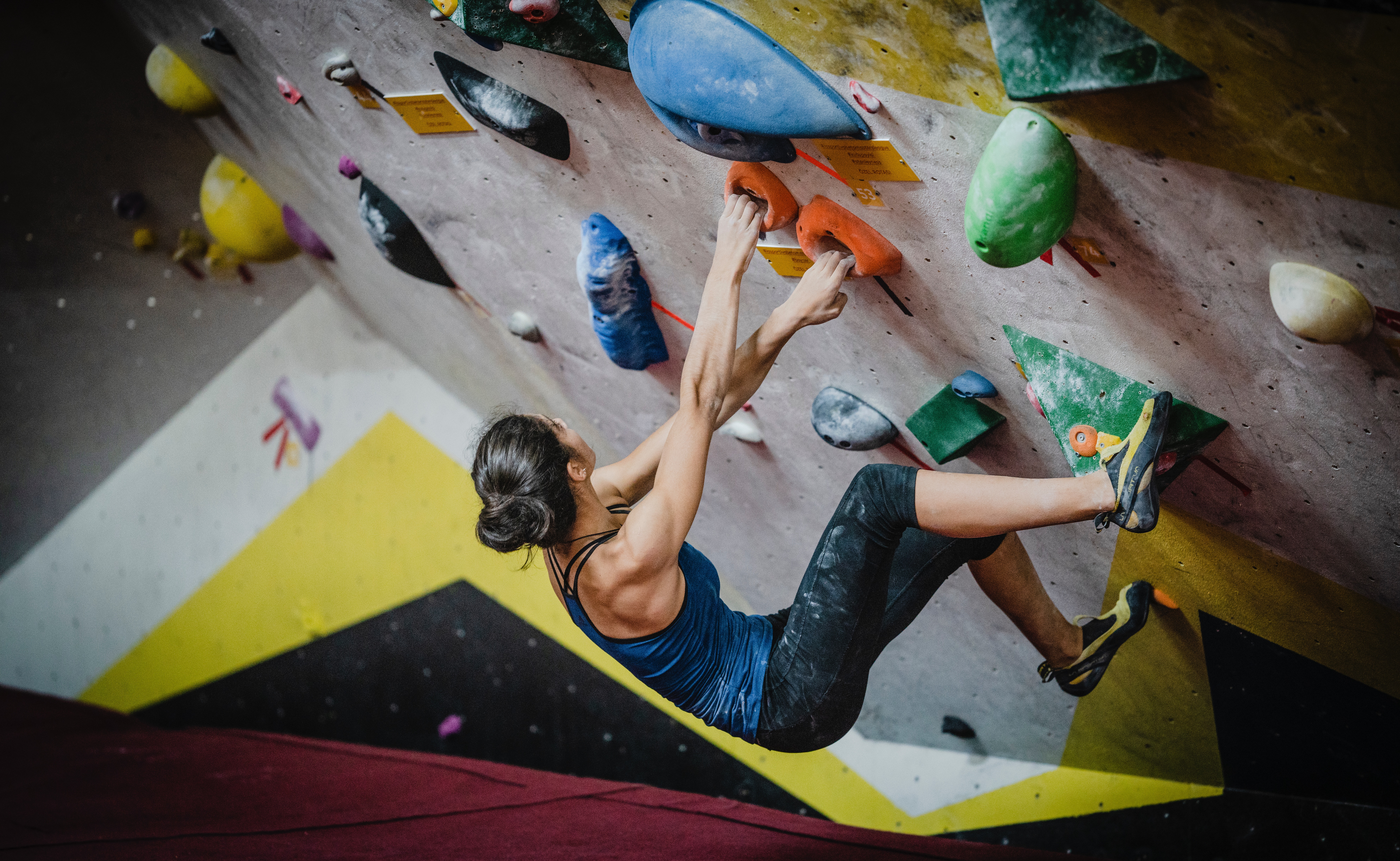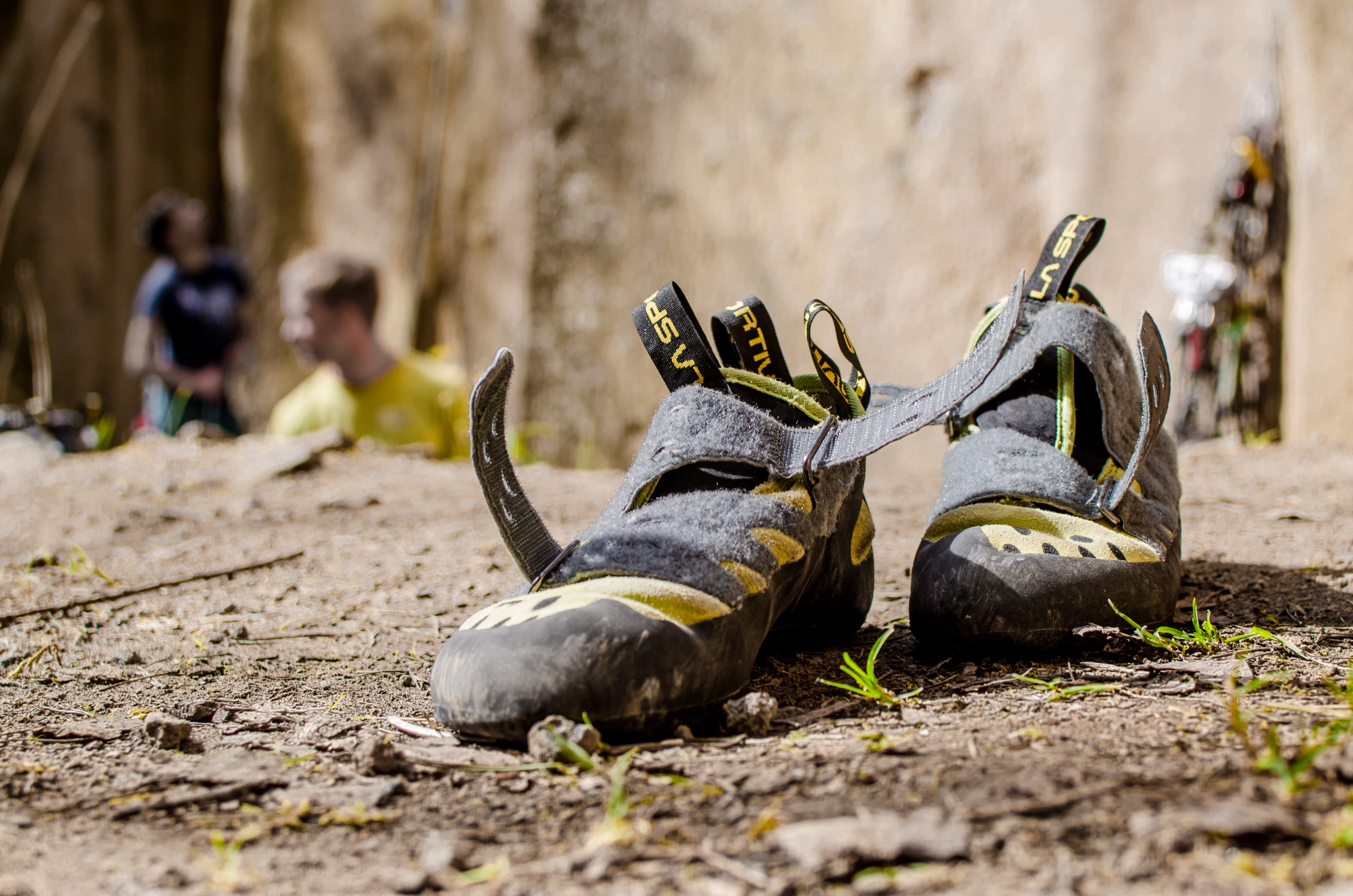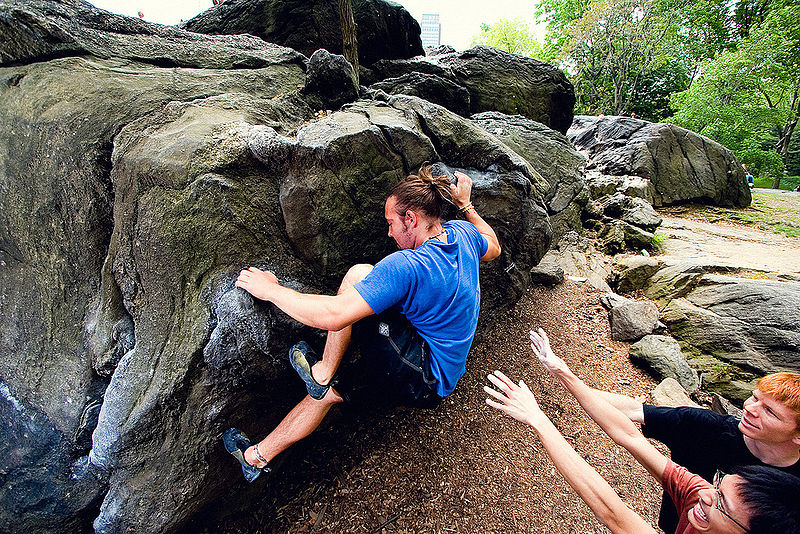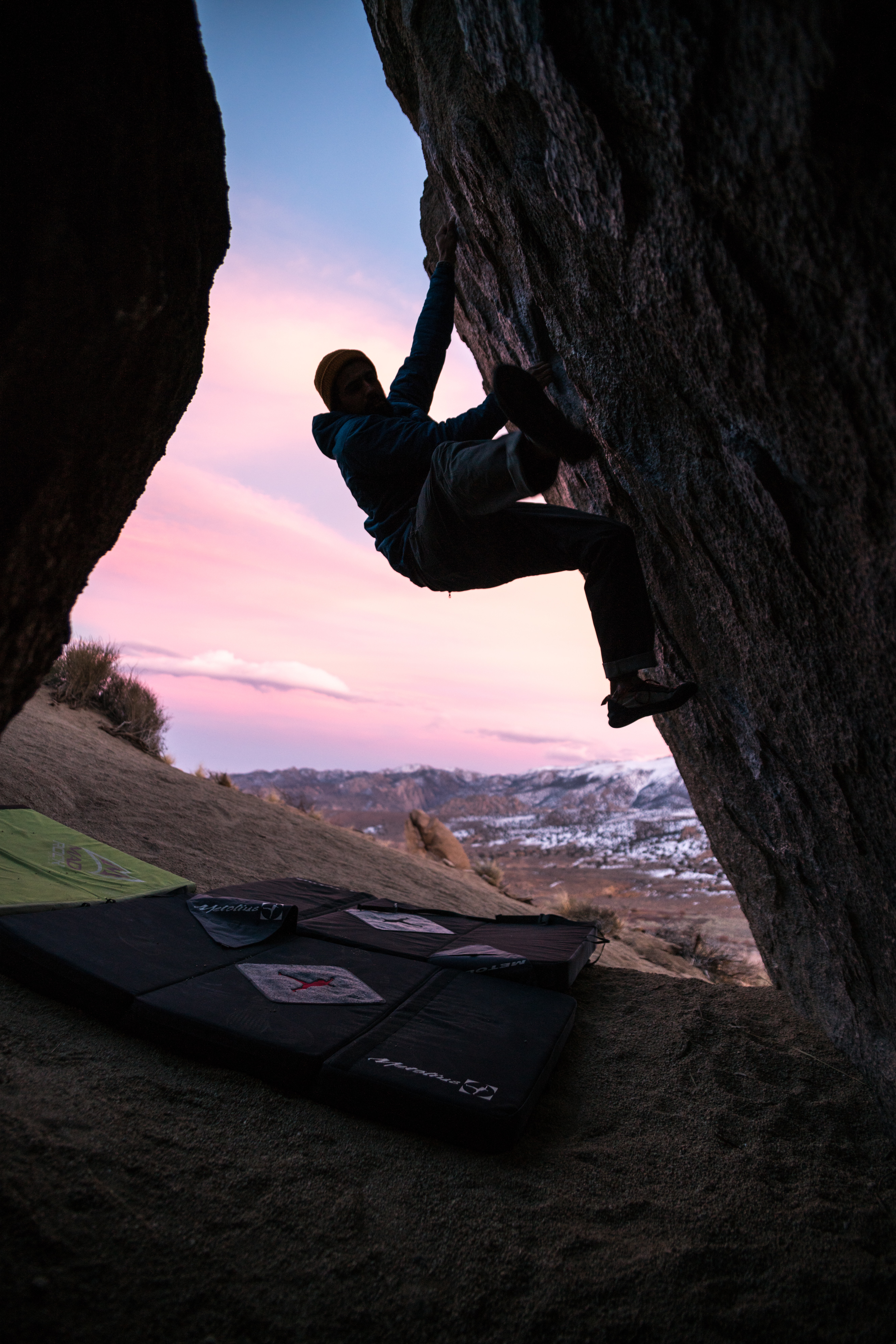What is Bouldering?
Are you interested in climbing but not quite ready to take the plunge?
Maybe the cost of gear is daunting, it’s hard for you to find partners, or you dislike the idea of being tethered to a rope and another person.
Whatever the reason, bouldering is a great way to test the waters. Bouldering (pronounced boldern) is arguably the purest form of rock climbing.
Participants are free from ropes, harnesses and climbing hardware — wearing only climbing shoes and using chalk and a chalk bag, if desired. You can boulder indoors on artificial holds or outdoors on small rock formations.
While most boulders are less than six meters in height, a form of the sport — known as highball bouldering — offers the opportunity to climb problems up to twelve meters in height.
Highball bouldering greatly pushes participants’ mental and physical limitations — but don’t be deterred — you won’t start on these types of problems when learning how to boulder.
Bouldering History
Early Origins
While you can’t nail down the birth of bouldering to a specific date, rock climbing began in the late 1800s. What is now considered modern-day bouldering started as training for big mountain ascents. The term “bouldering” first appeared in British climbing literature — with Oscar Eckstein serving as one of the sport’s earliest advocates in the British Isles.
Though not in the modern-day sense, Hassler Whitney (1907-1989) is considered one of the very early American boulderers and spent much of his life putting up routes without a rope in what are now known as Sleeping Giant State Park and East Rock Park.
Newell Martin predates Whitney by more than fifty years and is also regarded as one of the first American boulderers — however, his style was much less like how it is today. Also known as ‘buildering’, Martin scaled the towers and buildings on the campus of Yale University, which he attended beginning in 1875.
Early bouldering took place at Devil’s Lake in Wisconsin during the mid 1920s. Jan and Herb Conn started climbing at Carderock, located near Washington, DC, in the 1940s. John Stannard was among the next generation of hard climbers in the area and attributed with putting up the first modern boulder problem there.
Modern-Day Pioneers
In the 1950s in Stoney Point, California, the famous Royal Robbins and his crew participated in modern-day bouldering sessions — the first of their kind. Modern day bouldering also took place in the 1960s in the Needles of South Dakota with Bob Kamps, Rich Goldstone and Pete Cleveland being among the area’s bouldering pioneers.
Other bouldering locations around the country during this time included the Riverside Area, Yosemite, Toulumne Meadows, Flagstaff Mountain, Joshua Tree, The Buttermilks, The Gunks, Vedauwoo, and Morrison. In the late 1950s, American mathematician Jon Gill distinguished bouldering as its own discipline, developed the first problem-grading system, and introduced the use of chalk for keeping climbers’ hands dry. Gill’s developments — including the introduction of strength training — helped boost the bouldering discipline, increasing its popularity among climbers.
Continued Growth
The development of bouldering mats and indoor climbing walls in the 1980s marked a notable shift in the sport. Indoor bouldering allows for climbing in areas without boulders or cliffs while providing for a safe place for serious participants to train year-round.
Bouldering mats — more commonly known as “crash pads” — provide for safer outdoor participation by helping protect climbers against injury from falling.
Bouldering’s popularity grew exponentially in the early 2000s. Leaps in technology — namely, the Internet — allowed for the growth of climbing blogs and YouTube videos. These resources assisted interested parties with learning techniques, finding climbing destinations and tracking completed projects.
What are Bouldering Problems?
A boulder problem is a sequence of technical climbing moves like a climbing route but without ropes. Boulder problems require a combination of balance, strength and flexibility.
A problem is much shorter than a roped climbing route and demands more technical endurance. Bouldering problems are designed to be solved in a progressive fashion but depending on an individual’s height and skills, two people might solve one problem different ways.
Famous Boulder Problems in America
Slashface (V3/6A/A+), Joshua Tree National Park
Although most famous for its roped routes, Joshua Tree is also home to world-renowned boulder problems like Slashface.
Slashface ascends the central vertical face of the obvious boulder located on the approach to Jerry’s Quarry. Stonemaster John Bachar made the first ascent of the nearly 8-metre face. The problem requires crimping on diagonal breaks, navigating a low crux and topping out with a committing mantel.
Midnight Lightning (V8/7B+), Yosemite National Park
Ron Kaulk first ascended the steep face of the Columbia Boulder in 1978, followed closely by John Bachar. The two climbers had worked on the project for months before finally figuring it out.
Bachar dubbed it ‘Midnight Lightning’ because they first associated the probability of an ascent with getting struck by a lightning bolt at midnight.
The Thimble (V5/6C), Custer State Park
Based on his historic contributions to bouldering, it’s necessary to include John Gill’s first ascent of the Thimble on this list.
The boulder problem is technically a highball and considered by many to be an actual climbing route. John Gill’s 1961 ascent was pre-crash pad era and unrepeated for more than 20 years — making the feat that much more admirable.
The Orb (V8), Rocktown, Georgia
The Orb is considered by many climbers to be the most famous Southern region boulder problem. The photographic boulder is reminiscent of a UFO and often captured on camera because of its odd appearance.
The first ascent is unknown to this day. The problem begins under a roof on low jugs and continues up through the right side on glorious slopers complimented by open hand crimps and a toe hook. There are two cruxes: one between slopers and the other being the top out.
Famous Boulder Problems in Europe
Rainbow Rocket (V11/8A), Fontainebleau, France
Rainbow Rocket features one of the most famous dynos in the world. Alexis Allayaud is the first ascentionist and reportedly did not utilize the “high foot” beta climbers use to perform the move today, making his ascent that much more praiseworthy. The move itself measures about 250 centimeters from starting hold to finish.
Burden of Dreams (V17/9A), Lappnor, Finland
The first 9A boulder was unclimbed until 2016. It was long considered the hardest bouldering problem in the world. Nalle Hukkataival spent four years projecting the seemingly featureless 45 degree overhanging face before claiming the first ascent. Burden of Dreams consists of just five hard moves, reminiscent of the old-school style of bouldering.
Red Baron (7A+), Shipley Glen
Regarded as one of Yorkshire’s finest grit challenges, the Red Baron goes up an obvious hanging arete feature. Mike Hammil completed the fist ascent in 1976. Although the original route is the most famous, the Red Baron boulder offers a handful of other lines as well, including the Red Baron Roof and the Dead Baron.
Livin’ Large (V15/8C), Rocklands, South Africa
Finnish climber Nalle Hukkataival completed the first ascent of Livin’ Large in 2009. The project was codenamed “Big Real” up to its completion. The 8 meter boulder problem is comprised of 24 moves on an exquisite arete that ends with a crux on the very last move.
Bouldering vs. Rock Climbing
What’s the Difference?
The main differences between bouldering and rock climbing are the length of the climbs and the equipment used. Rock climbing requires participants to use a climbing rope, harness, and metal equipment for protection in the event of a fall.
The goal is to reach the top of a cliff or mountain and necessitates a combination of strength, stamina and endurance.
Participants that boulder typically wear only climbing shoes and a chalk bag around their waist, if desired. As opposed to rock climbing, no ropes or harnesses are used for protection when bouldering.
However, some participants choose to use crash pads to protect themselves from injury in the event of a fall.
Climbers can practice both forms of the sport indoors on climbing or bouldering walls and outdoors on natural features.
Most boulder problems are less than six meters in height and feature a succession of more complex body movements than you would generally find on a climbing route, while climbing routes are longer and require more endurance.
Where Can I Go Bouldering?
Indoor Bouldering
If you’re new to bouldering, indoor climbing gyms serve as the ideal place for testing the waters. There are bouldering-specific climbing gyms and traditional climbing gyms, which usually offer both areas for roped climbing and areas for bouldering.
When you’re bouldering indoors, individual problems will be marked with differently colored tape or holds — depending on the gym.
Climbing a specific problem means only using the holds in a single color. Problems are graded by difficulty — but the grading scale can vary widely from gym to gym.
Many gyms will also mark a finishing hold or provide a platform for topping out.
Outdoor Bouldering
It’s best to learn how to boulder indoors but once you’ve mastered some basic skills, you can take those skills outside.
More thinking is involved with outdoor bouldering as the problems are not marked with colors. Chalk marks from other climbers often offer suggestions for handholds and footholds but it’s important to remember that not everyone will climb a problem the same way. You might find an unmarked hold that serves as the key for you to finish a problem.
Finding and accessing outdoor boulders require the use of guidebooks or online resources and might also mean an approach hike to get there.
There’s more logistics involved in outdoor bouldering, so if it’s your first time, we recommend going with an experienced partner or group. While you can use a crash pad to help prevent injury if you fall, climbing outdoors is riskier than indoor bouldering — especially when you’re topping out.
This is because you then need to descend safely back down to the ground and while indoor gyms offer stairs or ladders, when you’re climbing outdoors you’ll either need to down climb the backside of a boulder or hike down, depending on the location.
Common Bouldering Locations
Bishop, California
California’s Sierra Nevada Mountain Range serves as one of the state’s many prime rock climbing destinations. The Happy Boulders Canyon and the Buttermilks are regarded as two of the best bouldering venues in the world. The Buttermilks comprise bold and aesthetic lines on quartz monzonite rock and feature famous problems including The Mandala, Evilution, Saigon, and High Plains Drifter.
The Happy Boulders Canyon offers a concentration of iconic boulder problems. Deceivingly brittle-looking volcanic Bishop Tuff rock features challenging faces marked with archetypal finger pockets and steep, juggy overhangs.
Fontainebleau, France
Bouldering in Fontainebleau, France dates back to the 1870s. The area’s history is almost as concentrated as the number of boulder problems — totaling far into the thousands.
Dense forest backdrops the breathtaking sandstone boulders that have something to offer for everyone, whether you’re a newbie or a seasoned pro. The Trois Pignons serves as one of the most popular destinations. Problems are organized into color-coded circuits according to their degree of difficulty, which adds to the area’s accessibility and convenience.
Squamish, British Columbia
Squamish, British Columbia is home to the best bouldering in Canada. The area is renowned for its stellar granite lines, but the boulder problems nestled amongst the trees beneath the shadow of the great granite monolith, The Chief, deserve equal praise.
There are more than 2500 problems divided up into 11 different areas including The Grand Wall Boulders, The Apron Boulder, The North Walls and Paradise Valley. A few of the most classic problems known to date are Tatonka, The Egg, and Titanic. Year-round cool temperatures offer a nice reprieve for climbers from warm climates.
Rocklands, South Africa
Tiger-striped sandstone boulders backdrop the impressive semi-desert landscape characterized by sunny weather and clear blue skies.
The Rocklands are home to a large concentration of easy and moderate problems — but there’s something for everyone to enjoy. The Rocklands are located about three hours north of Cape Town in the Cederberg Wilderness Area. A few classic problems include Sex Etiquette, Minki and The Rhino.
Bouldering Grades
Boulder problems are assigned grades depending on their level of difficulty — but grades are often subjective and frequently debated in the climbing community.
Different parts of the world use different grading scales which in of itself can cause confusion.
Grades can vary widely — especially from indoors to outdoors. The two most common bouldering grading systems are the V Scale (also known as the Hueco system) and the Font Scale (an abbreviation for the Fontainebleau Scale).
V Scale
John “Vermin” Sherman pioneered the V Scale whilst climbing the exquisite boulders of Hueco Tanks, Texas.
The V Scale is primarily used in North America and Oceania. The V Scale is a straightforward system that grades boulders from V0 (the easiest) up to — and possibly beyond — the hardest known boulder problem to date: Burden of Dreams, considered a V17.
Font Scale
The Font Scale is the most commonly used grading system throughout Europe and Asia.
This scale originated in Fontainebleau, France — attributing to its namesake. The Font Scale is regarded as the oldest boulder grading system in the world and originated decades before the V Scale.
It’s similar to the V Scale in that the higher the number means the harder the boulder problem — starting with the number 4, which equates to a V0 on the V Scale. However, the Font Scale is a bit more complex than the V Scale.
When the Font Scale gets to number 5, it then begins to use plus signs and letters to further define a problem’s difficulty. Here’s a breakdown of how the V Scale and the Font Scale compare and relate:
| V Scale | Font Scale |
|---|---|
| V0 | 4 |
| V1 | 5 |
| V2 | 5+ |
| V3 | 6A/6A+ |
| V4 | 6B/6B+ |
| V5 | 6C/6C+ |
| V6 | 7A |
| V7 | 7A+ |
| V8 | 7B/7B+ |
| V9 | 7B+/7C |
| V10 | 7C+ |
| V11 | 8A |
| V12 | 8A+ |
| V13 | 8B |
| V14 | 8B+ |
| V15 | 8C |
| V16 | 8C+ |
| V17 | 9A |
Other Systems
While the V Scale and the Font Scale are the most commonly found boulder grading scales in the world, there are a few others worth mentioning. It’s necessary to highlight the B Scale here for historic purposes.
The B Scale
In 1958, legendary boulderer John Gill developed the first ever grading scale exclusively applied to boulder problems in the United States — dubbed the B Scale. The B Scale includes only three grades: B1, B2 and B3.
Unlike traditional grading systems, the B Scale is not open ended — meaning there is no room to develop a “B4”, for example, even if a climber sent a problem they felt was markedly harder than a B3. Here’s a little more explanation on this:
A B1 boulder problem presented moves that rivaled the hardest moves found on roped climbs, while B2 problems were vaguely described as “harder than B1”. A problem earned a B3 rating only when it was completed for the first time. Once a B3 problem was completed a second time, it was downgraded to a B2 — thus upholding the system’s unique structure and integrity.
Bouldering Equipment
One of the biggest reasons many participants first break into bouldering is that the sport requires very little equipment to get started. The most important piece of bouldering equipment is a pair of climbing shoes.
If you’re not ready to buy your own or you’re not sure what kind of shoe is best for you, you can rent climbing shoes at your local gym. When you do invest in a pair of your own shoes, it’s best to do your research and pick out the climbing shoe that best meets your needs.
Apart from a quality pair of climbing shoes, all you need to start bouldering is decent chalk for your hands (if desired) and a chalk bag or bucket to contain it. What’s the difference?
A chalk bucket sits on the ground beside you while a chalk bag hangs from a strap around your waist. Whichever you choose comes down to personal preference and the length of the problems you’ll be climbing. If you plan on highballing or attempting long problems, it might be best to carry a chalk bag — especially if you’re a climber who benefits from chalking up while on route.
When (or if) you want to start bouldering outdoors, the last piece of equipment to consider investing in is a crash pad.
Since crash pads were first introduced in the 1980s, they’ve made the sport significantly safer by serving as mattress-like landing pads intended to cushion a fall and prevent injury. Modern day crash pads are extremely portable and easy to carry on your back from the car to the crag.
Our Picks for the Best Bouldering Shoes:
| Best For | Shoe | Closure | Upper Material |
|---|---|---|---|
| Best on a Budget | La Sportiva Tarantulace | Lace | Leather/Synthetic |
| Best for Beginners | Mad Rock Flash | Velcro | Leather/Synthetic |
| Best Overall | La Sportiva Solution | Velcro | Leather/Synthetic |
| Best Overall Runner-Up | Evolv Shaman | Velcro | Sythentic Suede |
How to Start Bouldering
What to Expect Your First Time
Learning how to boulder is a process — so don’t expect to send that cool-looking V5 during your first session.
Bouldering basics include learning sport-specific body movements, such as keeping your hips close to the wall and not over-gripping handholds.
There’s also a mental component — you’ll need to learn to calm your mind when you’re high off the ground. An indoor bouldering wall serves as the ideal environment for bouldering for beginners.
Climbing gyms differ depending on your location — but as a general rule, problems will be color-coded. Start on easy problems to develop your skills. Look for problems marked “Easiest”, “V0” or “4” (if a gym is using the Font Scale).
Expect to feel tired quickly — even after climbing just a handful of problems. Bouldering is an intense form of exercise that involves building strength in muscles, tendons and ligaments that you likely don’t use in other facets of your life — and this will only happen over time.
Pushing yourself too hard in the beginning is likely to result in injury, which will only slow your progress.
How to Fall Bouldering
Falling is an inherent part of bouldering. Gyms utilize crash pads and cushioned floors designed to absorb the impact of a fall, making a bouldering gym the ideal location for learning how to boulder.
Some climbers consider bouldering more dangerous than roped climbing in the context that every fall means hitting the ground — making injuries like sprained ankles and wrists much more common.
That’s why learning how to fall safely is an important component of bouldering. When you do fall, don’t try to grab onto holds or other features on your way down.
That might seem counterintuitive — but it will prevent you from painfully smacking yourself on hard plastic. Instead, push away from the wall when you fall, relax your body (don’t brace!) and prepare for landing.
If possible, try to land with your feet flat and your knees bent so that you absorb the shock through your knees.
It’s okay to continue to fall and roll onto one side — in fact, that’s a good practice. Try to avoid catching yourself with your hands or absorbing impact through your wrists. You’re much more likely to injure yourself this way.
Spotting
If you’re climbing with a friend or a group, spotting is a great way to assist each other while climbing — especially with preventing injury in the event of a fall. Boulderers can spot each other at the gym or outside.
A spotter’s job is to stand below the climber with their arms raised upright. The spotter’s job is not to catch the climber if they fall but to redirect their fall so that they land safely on a crash pad.
When bouldering outdoors, the primary purpose of spotting is to prevent the falling climber’s head from hitting the ground — especially because you’re not wearing a helmet when you’re bouldering. The primary purpose of spotting is accident prevention.
Bouldering Tips for Beginners
- Use gym etiquette: Before snagging a crash pad out from under another climber, first ask if they’re finished using it.
- Take turns: Especially when the gym is crowded, be mindful of other climbers and be sure to share your problems with others.
- Don’t spray: While some climbers appreciate beta (giving advice on how to solve a problem), don’t give it unless they ask for it.
- LNT: Apply “Leave No Trace Ethics” when bouldering outdoors.
- Be mindful of your belongings: If another climber lands on your carelessly placed water bottle, they could sustain an injury (at worst) or write you off as a future climbing companion (at best).
Bouldering Terminology
Here’s a compilation of common bouldering terms and their meanings:
- Beta: Advice on how to execute a movement or complete a sequence of movements.
- Crux: The most difficult part of a climb, often involving one or more consecutive moves.
- Dyno: A dynamic move that requires both hands and often both feet to leap from one position on the wall to the next.
- Flash: To flash a problem is to climb it successfully after having seen another climber complete it or on your second attempt at completing it.
- Highball: A boulder problem higher than about six meters in height or tall enough that a fall from the top would likely result in injury.
- Onsight: To successfully climb a problem on your first try without beta or watching another climber finish it.
- Project: To project is to choose a problem at or just above your skill level and spend time learning individual moves until you can put the sequence together and execute the moves in succession (i.e. send the climb).
- Send: To climb a problem without falling.
- Soft: A soft grade is one that seems easier than the rating.
- Spray: Offering unsolicited beta to another climber.
- Stiff: A stiff grade is one that seems harder than the rating.
- Traverse: A lateral movement across the wall.
Bouldering Competitions
What are Bouldering Competitions and When Do They Take Place?
Bouldering competitions are usually held indoors on climbing walls. They’re a great way to showcase your skills in front of an audience and see how you stack up against your peers.
Competitions are popular in the climbing world as a way to bring sport enthusiasts together and offer opportunities to test your skills on different types of problems.
If you’re new to bouldering, the idea of a competition might seem a bit intimidating - but it doesn’t have to be. Many climbers participate in competitions for the social aspect of the sport - plus, there’s often free swag to snag!
Bouldering competitions take place all around the world so the key is to find the closest ones to you.
To find out more, connect with your local bouldering gym, search for opportunities online or via social media, or reach out to fellow climbers. Here are some great tips to consider if you’re thinking about trying out for your first climbing competition.
Bouldering Rules
As with any sport, bouldering employs its own set of rules.
While competition rules can vary from the basic rules of your indoor gym, similar principles apply.
Boulder problems begin on a designated start hold, follow a marked sequence up the wall and finish with an ending hold or top out. The start of a boulder problem requires that all four limbs are off the ground in designated places or freely flagging on the wall.
General climbing etiquette rules apply to bouldering, including the leave no trace ethics and tips for beginners we listed above.
